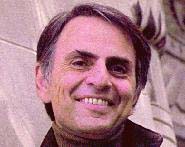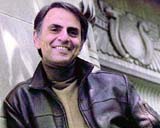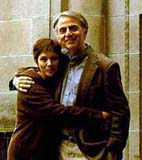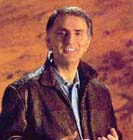The Rediff Special / Carl Sagan
'Hindu cosmology's time-scale for the universe is in consonance
with modern science'
 Carl Sagan, the distinguished Cornell University astronomer
and Pulitzer Prize-winning author, who succumbed to his battle
against cancer on December 15, in fact lived for millions of years
in the relative time scale of experience.
Carl Sagan, the distinguished Cornell University astronomer
and Pulitzer Prize-winning author, who succumbed to his battle
against cancer on December 15, in fact lived for millions of years
in the relative time scale of experience.
This legend in his own lifetime was a first grade philosopher,
poet, scientist and a splendid example of human greatness all
rolled into one.
His true genius lay in the many esoteric philosophical and
scientific endeavours which only specialists can really appreciate.
But he became an instant pop science icon when he co-authored
COSMOS, a television series devoted to astronomy and space
exploration.
A part of that awesome series was shot in India. In the early
eighties, Sagan met then Indian diplomat Placido P D'Souza
and in a conversation explained the India connection and the
relevance of Gandhi.
You have been host of the television programme COSMOS
which deals with astronomy and science exploration. And yet India
figured in this programme. Could you tell us how India fits into
this series?
Let me first say something about the series in general, and
something about the Indian part of the series. The television
series COSMOS is designed to breach the barrier that many
people feel about science. They cannot understand it, and it is
foreign to them in approach and content. Our experience is that
children grow up with an absolute zest and passion for science,
and something happens to discourage some of them - sometimes many
of them - from pursuing this interest.
We thought it was our job to excite the children, and reawaken
the interest in science of adults. So we will use any approach
to gain people's attention, and show them that science is something
not just that they can understand, but that they can become excited
about and can use as part of the way they view the world.
The series has been extraordinarily successful. It has been shown
in a year or two in the Soviet Union and the People's Republic
of China. I hope some day it will be shown in India. The tenth
episode of COSMOS is largely about cosmology - the study
of the universe in a perspective in which the Earth is like a
grain to stand in vast beach or desert - and the way we approach
the subject is through Hindu cosmology.
We have done that for several reasons. We went to Tamil Nadu for
the festival called Pongal. Like festivals all over the world,
it celebrates the changing of the seasons, and remind us that
our ancestors were astronomers, who kept calendars and watched
the skies. It was essential for extremely practical matters: when
to sow seeds and to harvest grain. It was a matter of life and
death to be an astronomer.
 But the main reason that we oriented this episode of COSMOS
towards India is because of that wonderful aspect of Hindu cosmology
which first of all gives a time-scale for the Earth and the universe
-- a time-scale which is consonant with that of modern scientific
cosmology. We know that the Earth is about 4.6 billion years old,
and the cosmos, or at least its present incarnation, is something
like 10 or 20 billion years old. The Hindu tradition has a day
and night of Brahma in this range, somewhere in the region of
8.4 billion years.
But the main reason that we oriented this episode of COSMOS
towards India is because of that wonderful aspect of Hindu cosmology
which first of all gives a time-scale for the Earth and the universe
-- a time-scale which is consonant with that of modern scientific
cosmology. We know that the Earth is about 4.6 billion years old,
and the cosmos, or at least its present incarnation, is something
like 10 or 20 billion years old. The Hindu tradition has a day
and night of Brahma in this range, somewhere in the region of
8.4 billion years.
As far as I know. It is the only ancient religious tradition on
the Earth which talks about the right time-scale. We want to get
across the concept of the right time-scale, and to show that it
is not unnatural. In the West, people have the sense that what
is natural is for the universe to be a few thousand years old,
and that billions is indwelling, and no one can understand it.
The Hindu concept is very clear. Here is a great world culture
which has always talked about billions of years.
Finally, the many billion year time-scale of Hindu cosmology is
not the entire history of the universe, but just the day and night
of Brahma, and there is the idea of an infinite cycle of births
and deaths and an infinite number of universes, each with its
own gods.
And this is a very grand idea. Whether it is true or not, is not
yet clear. But it makes the pulse quicken, and we thought it was
a good way to approach the subject.
And then the Chola bronzes in Tamil Nadu were very lovely to film,
and gave us a visual approach to go along with the intellectual
approach. It was also a way of de-provincialising our presentation.
After all, we claim that science is an endeavor of the human species.
To shoot the whole film in the United States or Western Europe
would have been extremely provincial. We shot in Japan and 12
or 14 other countries, besides India. Let me also say that the
subsidiary benefit for my wife and me is that we had a chance
to visit India for the first time, and especially Tamil Nadu which
we enjoyed enormously.
You mentioned the Chola bronzes and I see also that in your
book COSMOS one of the chapters called 'The edge of forever'
begins with a picture of Nataraja. Could you say something to
explain its relevance in that chapter?
The traditional explanation of the Nataraja is that it symbolises
the creation of the universe in one hand and the death of the
universe in the other - the drum and the flame - and after all,
that is what cosmology is all about. So in addition to being artistically
exquisite, the Nataraja provides exactly the kind of symbolism
that we wanted. The Nataraja that is photographed in the book
COSMOS is in a museum in Pasadena, California, but it will
be returned to India at some specified time within the next decade.
What were your general impressions about India?
I was absolutely delighted with Tamil Nadu. First of all,
there was the sense of an intact cultural framework. I did not
have the sense of people greatly alienated from their society
- you certainly see a great deal of that in the West. I had a
sense of people caring for each other, an intact social fabric,
and technology coming along quite fast. Not just large industrial
parks.
In a way what impressed me most was the widespread use of the
bicycle, not only for carrying agricultural products and manufactures
from one place to another, but also as a means for young people
to visit neighbouring villages, and a sense of exuberant communication,
because now people are not closed in a small village. They have
a much wider range of places that they have access to.
We spent some time in Madras and in Bombay. But these were slow
stages to get us to Tamil Nadu. We saw mainly tourist things which
were certainly pleasant, but we did not have the sense of getting
to know the people. We could have, but it did not work out that
way, whereas in Tamil Nadu we got to know the people.
I will give you an example. Here we are at 6:30 or 7 in the morning
- a group of us consisting of cameramen, soundmen, writers, directors,
producers and me, who go marching single file by a pond in which
there are lovely lily and lotus blossoms. Going to two small temples
of the bull god (Nandi). A boy, less than 10 years old, saw us
coming, looked at us, dove into the pond and came up near a lotus
flower. He then swam back with it, climbed out of the pond, went
up to my wife, gave her the lotus blossom and introduced himself,
saying "Hello, my name is…" I forget what his name
was. It was done with such elegance and charm and with no thought
of reward, but just a sensibility which I found very impressive.
Anyway we loved it. How colorful it was…
 I must also say the sari is a kind of work of art, especially
seeing hundreds of them all together. Also, women washing the
saris gives a kind of swatch of color to the landscape… I
thought it was wonderful… I had a sense of a healthy society.
I didn't know to what extent this is characteristic or not, but
I was very impressed and would love to have a chance to go back…
I must also say the sari is a kind of work of art, especially
seeing hundreds of them all together. Also, women washing the
saris gives a kind of swatch of color to the landscape… I
thought it was wonderful… I had a sense of a healthy society.
I didn't know to what extent this is characteristic or not, but
I was very impressed and would love to have a chance to go back…
Well, you know you have a standing invitation to visit India…Was
that your first visit?
Yes. I had been invited before by a number of people, including
J B S Haldane, a British biologist in Bhubaneshwar. I knew him
well in the last few years of his life. He even made me promise
to visit him in Orissa, but he died before I had a chance to do
so.
Did you know any other Indian scientists?
Oh, yes. I knew Vikram Sarabhai who spent a year at Cambridge,
Massachusetts, when I was on the Harvard faculty. I was a student
of the world-renowned astrophysicist Subramanian Chandrasekhar
at the University of Chicago. An old friend from the graduate
school days in Kameshwar Wali, now a Professor of Physics at Syracuse
University. For 17 years a close colleague who has been working
with me in laboratory experiments on the origins of life is Bishun
Khare. So I had a succession of fairly close friendships with
Indians. I have always felt some natural affinity, I suppose.
Have you seen the Gandhi film?
Yes. It well deserved the Academy awards. I though it was
splendid on many different levels. One is the idea that there
are ways for the people to move governments by unconventional
approaches including civil disobedience - but not only civil disobedience
- at a time when, in my view, the people of at least some countries
have much more sensible views about the nuclear arms are than
their governments. They can affect the policies of governments
that seem to be slow-moving, intractable and riddled with a bureaucracy
that is decades behind the times.
Also, the American civil rights, movement, of course, was powerfully
influenced by the degree to which Martin Luther King, Jr admired
Mohandas Gandhi, and I think that it is important for us, Americans,
to remember that connection… of the time when events in India
were relevant to events in the United States. That kind of thing
seems to me to be extremely important.
It has been argued that this kind of movement is all right
in a colonial situation and in very special circumstances, but
when you have functioning democracies, is it valid to adopt what
could be considered extra constitutional measures?
Right… or the opposite question: in a country like Nazi
Germany, would civil disobedience have in any way been effective?
Would the leaders of civil disobedience not have been executed
and nothing would have changed? They are both good questions,
and my answer is that the approach of Gandhiji is not precisely
applicable in every political situation. However, the reminder
that there are conventional ways of affecting the perceptions
of masses of people on issues of the greatest importance is very
important reminder.
In democracies - you talk about functioning democracies - there
are traditions. For example, the approaches to the nuclear arms
race are institutionalised, and progress is made very slowly.
Armaments are increased easily, decreased with great difficulty,
and people think about historical analogies of Munich in 1938
and so on without fully having come to grips with the fact that
the invention of nuclear weapons has changed everything. And for
that reason I think that something other than politics is necessary
when all nations and the human species are faced with the extremely
grave possibilities of a nuclear war.
I am not saying that civil disobedience is necessarily the answer.
But one thing which was so impressive about Gandhiji was
the way he was able to communicate to large numbers of people
and to excite people's passion and courage. There was a great
deal of courage needed to have followed him, especially in the
early days of his movement.
I think something along those lines is needed worldwide if we
are to break out of this impasse in the nuclear arms race.
 Also, I thought the movie was beautifully filmed, and in many
places, extremely moving. Maybe the most moving for me was the
scene toward the end, in which Gandhiji says to the despairing
man who has killed children in a riot: "I know a way out
of hell". I found that an enormously moving approach to the
problem, that the way for a Hindu, to make recompense for participating
in the riots, is to raise a Muslim child as a Muslim and vice
versa.
Also, I thought the movie was beautifully filmed, and in many
places, extremely moving. Maybe the most moving for me was the
scene toward the end, in which Gandhiji says to the despairing
man who has killed children in a riot: "I know a way out
of hell". I found that an enormously moving approach to the
problem, that the way for a Hindu, to make recompense for participating
in the riots, is to raise a Muslim child as a Muslim and vice
versa.
I thought it was a superb movie and well deserving of the acclaim
it has gotten here and elsewhere.
It has certainly made an impact, and moved people to think
about Gandhi and India. To the extent that it has made people
think a little, it has served its purpose.
I agree, it demonstrates that extremely unconventional approaches
are practical politics. Surely Gandhi has made major achievements
in practical politics by methods that the British discounted immediately,
and were proved wrong. It is good to remember that…
Placido P D'Souza is a former member of the Indian Foreign Service
and currently editor of New India Digest.
|





 Carl Sagan, the distinguished Cornell University astronomer
and Pulitzer Prize-winning author, who succumbed to his battle
against cancer on December 15, in fact lived for millions of years
in the relative time scale of experience.
Carl Sagan, the distinguished Cornell University astronomer
and Pulitzer Prize-winning author, who succumbed to his battle
against cancer on December 15, in fact lived for millions of years
in the relative time scale of experience.
 But the main reason that we oriented this episode of COSMOS
towards India is because of that wonderful aspect of Hindu cosmology
which first of all gives a time-scale for the Earth and the universe
-- a time-scale which is consonant with that of modern scientific
cosmology. We know that the Earth is about 4.6 billion years old,
and the cosmos, or at least its present incarnation, is something
like 10 or 20 billion years old. The Hindu tradition has a day
and night of Brahma in this range, somewhere in the region of
8.4 billion years.
But the main reason that we oriented this episode of COSMOS
towards India is because of that wonderful aspect of Hindu cosmology
which first of all gives a time-scale for the Earth and the universe
-- a time-scale which is consonant with that of modern scientific
cosmology. We know that the Earth is about 4.6 billion years old,
and the cosmos, or at least its present incarnation, is something
like 10 or 20 billion years old. The Hindu tradition has a day
and night of Brahma in this range, somewhere in the region of
8.4 billion years.
 I must also say the sari is a kind of work of art, especially
seeing hundreds of them all together. Also, women washing the
saris gives a kind of swatch of color to the landscape… I
thought it was wonderful… I had a sense of a healthy society.
I didn't know to what extent this is characteristic or not, but
I was very impressed and would love to have a chance to go back…
I must also say the sari is a kind of work of art, especially
seeing hundreds of them all together. Also, women washing the
saris gives a kind of swatch of color to the landscape… I
thought it was wonderful… I had a sense of a healthy society.
I didn't know to what extent this is characteristic or not, but
I was very impressed and would love to have a chance to go back…
 Also, I thought the movie was beautifully filmed, and in many
places, extremely moving. Maybe the most moving for me was the
scene toward the end, in which Gandhiji says to the despairing
man who has killed children in a riot: "I know a way out
of hell". I found that an enormously moving approach to the
problem, that the way for a Hindu, to make recompense for participating
in the riots, is to raise a Muslim child as a Muslim and vice
versa.
Also, I thought the movie was beautifully filmed, and in many
places, extremely moving. Maybe the most moving for me was the
scene toward the end, in which Gandhiji says to the despairing
man who has killed children in a riot: "I know a way out
of hell". I found that an enormously moving approach to the
problem, that the way for a Hindu, to make recompense for participating
in the riots, is to raise a Muslim child as a Muslim and vice
versa.